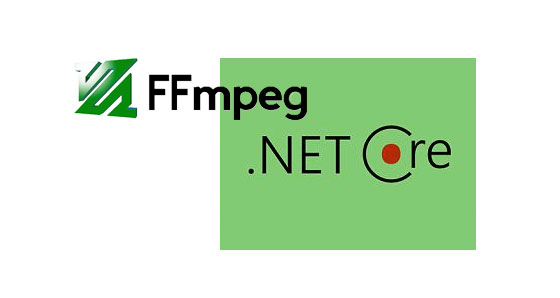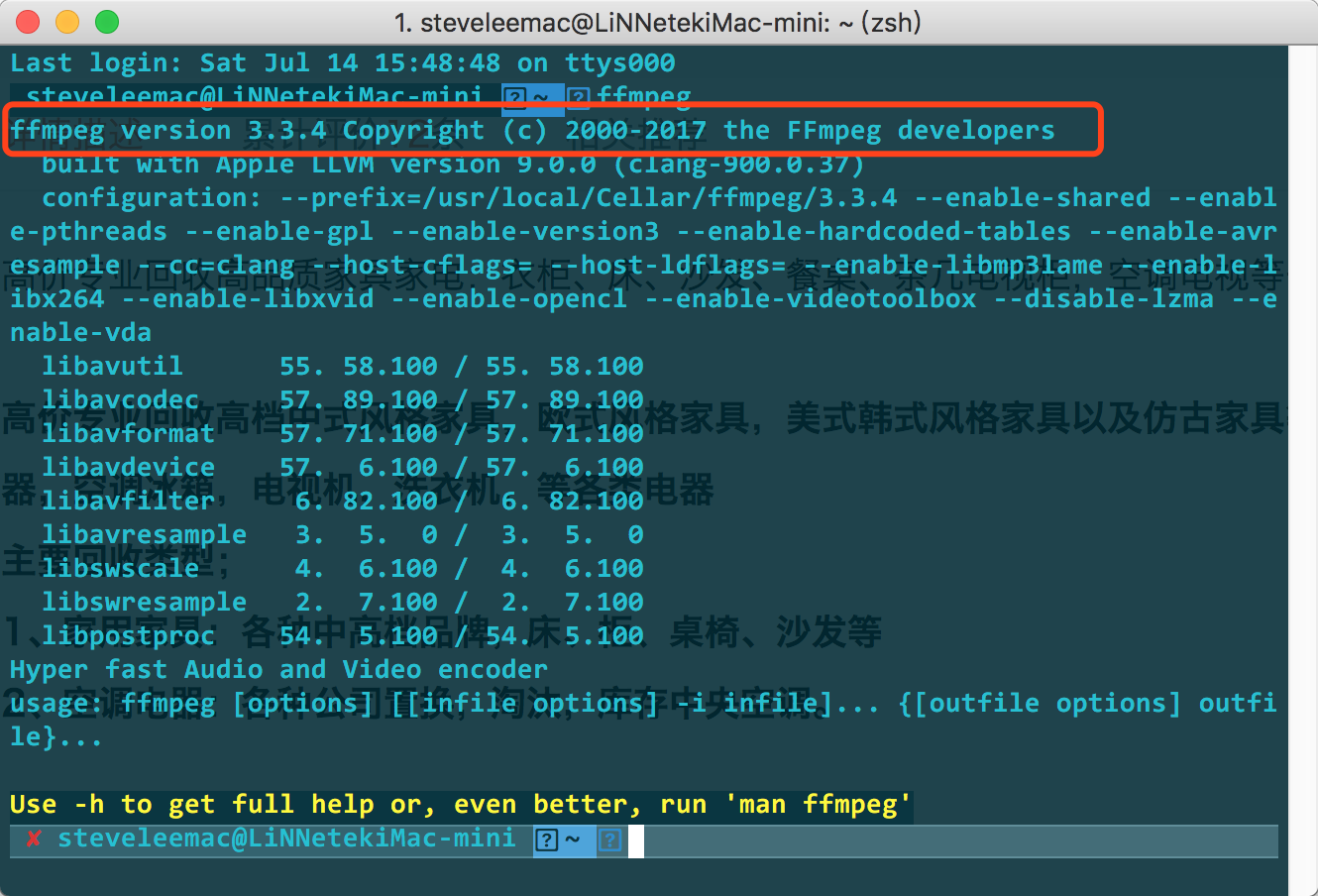準備工作: 1:Net Core 2.1 為何要用2.1,因為在macOS 10.13上一個奇怪的問題,請看另一篇博文介紹 2:FFmpeg 版本無所謂,最新即可,安裝教程網上很多,當然也可以使用docker進行ffmpeg的部署,下載地址 http://ffmpeg.org/download.ht ...

準備工作:
1:Net Core 2.1 為何要用2.1,因為在macOS 10.13上一個奇怪的問題,請看另一篇博文介紹
2:FFmpeg 版本無所謂,最新即可,安裝教程網上很多,當然也可以使用docker進行ffmpeg的部署,下載地址 http://ffmpeg.org/download.html
3:Rider 2018.1.2 在多平臺上,比微軟爸爸的VS好用,在window上肯定不如VS,當然你喜歡VSCODE也可以,畢竟JET的全家桶更好吃,哈哈。
目前準備工作就這樣,後續需要添加的時候再一一告知。
好了,開始碼磚。
創建一個簡單的Net core web api應用程式
當你使用dotnet new或者使用IDE創建完成一個web項目後,該項目就已經可以運行,不過只是一個空殼子,我們需要一些存儲全局變數和控製程序啟動的方式。在Program.cs中的Main函數修改如下
1 public static void Main(string[] args) 2 { 3 var config = new ConfigurationBuilder() 4 .AddCommandLine(args) 5 .Build(); 6 7 General.ConfigurationBuilder = config; 8 General.LocalHostUrl = config["ASPNETCORE_URLS"]; 9 General.isOpenMiddleware = bool.Parse(config["OPEN_MIDDLEWARE"]); 10 11 var host = new WebHostBuilder() 12 .UseEnvironment(config["ASPNETCORE_ENVIRONMENT"]) 13 .UseUrls(config["ASPNETCORE_URLS"]) 14 .UseConfiguration(config) 15 .UseKestrel() 16 .UseContentRoot(AppDomain.CurrentDomain.BaseDirectory) 17 .UseIISIntegration() 18 .UseStartup<Startup>() 19 .Build(); 20 21 host.Run(); 22 }
相信不用解釋太多,各位也明白上面每條語句的作用。筆者使用General靜態類存儲了來之外部命令的啟動參數,這種方式可以避免使用launcthSettings.json進行文件配置,通過啟動參數直接給定運行方式和環境配置。在使用的過程中可以通過例如:--ASPNETCORE_ENVIRONMENT=Development --ASPNETCORE_URLS=http://localhost:5023 --OPEN_MIDDLEWARE=true進行啟動,前兩個參數不解釋,第三個參數是為了方便多台伺服器部署時候,是否啟動相關的自定義中間件(相關中間件後續章節介紹)。既然本節介紹FFmpeg的使用,那麼接下來我們討論FFmpeg的使用方式。
ffmpeg是什麼
從度娘(當然你要用谷歌也行)上面抄個介紹:FFmpeg是一套可以用來記錄、轉換數字音頻、視頻,並能將其轉化為流的開源電腦程式。採用LGPL或GPL許可證。它提供了錄製、轉換以及流化音視頻的完整解決方案。它包含了非常先進的音頻/視頻編解碼庫libavcodec,為了保證高可移植性和編解碼質量,libavcodec里很多code都是從頭開發的。
簡單的說:就是可以處理音視頻媒體的開源程式。
安裝方式這裡不做闡述,安裝完成後輸入ffmpeg會得到如下信息。

請忽略截圖中的問號和亂碼,不想去折騰zsh。
在http://ffmpeg.org/官網上有詳細命令的使用和介紹,這裡介紹個簡單的命令
ffmpeg -i input.mp4 output.avi
該命令輸入一個input.mp4 文件,輸出一個output.avi文件,ffmpeg自動將mp4轉碼為avi文件並輸出到當前硬碟目錄,就這麼簡單!
通過Process類進行簡單的進程通訊
當然,我們不可能通過純手動的命令行的方式去得到自己想要的文件,這種方式對於伺服器而言也不可取,不過,Net為我們提供了Process進行與進程間通訊的簡單訪問,其實最多也就是命令行的調用,編寫一個通用的處理方法,方便不同地方的調用。
1 public void DoProcessing(string param, ProcessType processType = ProcessType.Ffmpeg) 2 { 3 try 4 { 5 _process.StartInfo.FileName = GetEnvironmentalFfmpeg(GetProcessName(processType)); 6 _process.StartInfo.Arguments = param; 7 _process.StartInfo.CreateNoWindow = true; 8 _process.StartInfo.UseShellExecute = false; 9 _process.StartInfo.RedirectStandardOutput = true; 10 _process.StartInfo.RedirectStandardInput = true; 11 _process.StartInfo.RedirectStandardError = true; 12 13 _process.ErrorDataReceived += (sender, args) => 14 { 15 if (sender is Process p && p.HasExited && p.ExitCode == 1) 16 { 17 Console.WriteLine("have an error:" + args.Data); 18 } 19 }; 20 21 if (processType == ProcessType.Ffprobe) 22 { 23 _process.ErrorDataReceived += (sender, args) => 24 { 25 if (args.Data == "") return; 26 FfprobeDataReceivedEventHandlerArgs?.Invoke(sender, args); 27 }; 28 } 29 30 _process.Start(); 31 _process.BeginErrorReadLine(); 32 _process.WaitForExit(); 33 } 34 catch (Exception ex) 35 { 36 Console.WriteLine(ex); 37 } 38 finally 39 { 40 _process.Close(); 41 _process.Dispose(); 42 } 43 }
以上實現方式都非常簡單,這裡筆者增加了一個委托FfprobeDataReceivedEventHandlerArgs函數,方便觸發輸出事件ErrorDataReceived在其他類中方便被調用,而Ffprobe能獲取到音視頻媒體的詳細信息,後面代碼中會介紹。
GetEnvironmentalFfmpeg是筆者為了偷懶,在windows中並沒直接安裝ffmpeg程式,而是將exe程式直接綁在了項目dll中,方便該項目在其他win平臺的二次調用,而免去再次安裝的繁瑣問題(linux和mac沒法偷懶,除非用docker直接拷貝鏡像文件)
GetProcessName函數就是一個主命令的選擇方式,ffmpeg中包含三個主要命令,ffmpeg用於處理音視頻,ffplay用於播放,ffprobe用於獲取信息,常用的主命令也就ffmpeg和ffprobe。
簡單的參數工廠
當然,我們通過一個簡單的主函數去調用ffmpeg命令是遠遠不夠的,還需要根據不同的需求封裝一下參數字元串的拼接方式,畢竟這麼多參數我可記不住,呵呵。筆者提供一個思路和模板,有興趣的朋友的借鑒和參考一下。
1 /// <summary> 2 /// FFMPEG參數構造工廠 3 /// </summary> 4 public class AudioParamFactory 5 { 6 private static string GetRandFileName() 7 { 8 return GetDictory() + "temp/" + GetRandomString(6, true, true, true, false, "") + ".mp3"; 9 } 10 11 private static string GetDictory() 12 { 13 return AppDomain.CurrentDomain.BaseDirectory; 14 } 15 16 /// <summary> 17 /// 調整音量大小 18 /// </summary> 19 /// <param name="inputFilePath"></param> 20 /// <param name="volumeSize"></param> 21 /// <returns></returns> 22 public AudioParamConstructor AdjustVolume(string inputFilePath, int volumeSize = 100) 23 { 24 var outputFile = GetRandFileName(); 25 return new AudioParamConstructor 26 { 27 Paramter = $"-i {inputFilePath} " + 28 $"-vol {volumeSize} {outputFile} -y", 29 NewFileName = outputFile 30 }; 31 } 32 33 /// <summary> 34 /// 合併兩個音頻文件 35 /// </summary> 36 /// <param name="inputFile1"></param> 37 /// <param name="inputFile2"></param> 38 /// <returns></returns> 39 public AudioParamConstructor MergeTwoAudio(string inputFile1, string inputFile2) 40 { 41 var outputFile = GetRandFileName(); 42 return new AudioParamConstructor 43 { 44 Paramter = $"-i {inputFile1} " + 45 $"-i {inputFile2} " + 46 "-filter_complex amix=inputs=2:duration=first:dropout_transition=10 -y " + 47 $"{outputFile}", 48 NewFileName = outputFile 49 }; 50 } 51 52 /// <summary> 53 /// 拆分音頻文件 54 /// </summary> 55 /// <param name="inputFile1"></param> 56 /// <param name="startTime"></param> 57 /// <param name="durtionTime"></param> 58 /// <returns></returns> 59 public AudioParamConstructor InterceptAudio(string inputFile1, TimeSpan startTime, TimeSpan durtionTime) 60 { 61 var outputFile = GetRandFileName(); 62 return new AudioParamConstructor 63 { 64 Paramter = $"-i {inputFile1} -vn -acodec copy -ss " + 65 $"{startTime.Hours:00}:{startTime.Minutes:00}:{startTime.Seconds:00}.{startTime.Milliseconds:000} -t " + 66 $"{durtionTime.Hours:00}:{durtionTime.Minutes:00}:{durtionTime.Seconds:00}.{durtionTime.Milliseconds:000} " + 67 $"{outputFile}", 68 NewFileName = outputFile 69 }; 70 } 71 72 /// <summary> 73 /// 拼接多個音頻文件 74 /// </summary> 75 /// <param name="inputList"></param> 76 /// <returns></returns> 77 public AudioParamConstructor SplicingAudio(IEnumerable<string> inputList) 78 { 79 var splic = inputList.Aggregate("", (current, input) => current + input + "|"); 80 splic = splic.Remove(splic.Length - 1, 1); 81 splic = $"\"concat:{splic}\""; 82 var outputFile = GetRandFileName(); 83 return new AudioParamConstructor 84 { 85 Paramter = $"-i {splic} -acodec copy {outputFile}", 86 NewFileName = outputFile 87 }; 88 } 89 90 /// <summary> 91 /// 獲取音頻文件信息 92 /// </summary> 93 /// <param name="inputFile"></param> 94 /// <returns></returns> 95 public string GetFileInfo(string inputFile) 96 { 97 return $"-i {inputFile} -print_format json -v 0 -show_format"; 98 } 99 100 /// <summary> 101 /// 鍵入效果 102 /// </summary> 103 /// <param name="inputFile"></param> 104 /// <returns></returns> 105 public AudioParamConstructor FadeIn(string inputFile, int startSecends) 106 { 107 var outputFile = GetRandFileName(); 108 return new AudioParamConstructor 109 { 110 Paramter = $"-i {inputFile} -filter_complex afade=t=in:ss={startSecends}:d=2 {outputFile}", 111 NewFileName = outputFile 112 }; 113 } 114 115 /// <summary> 116 /// 漸出效果 117 /// </summary> 118 /// <param name="inputFile"></param> 119 /// <returns></returns> 120 public AudioParamConstructor FadeOut(string inputFile, int startSecends) 121 { 122 var outputFile = GetRandFileName(); 123 return new AudioParamConstructor 124 { 125 Paramter = $"-i {inputFile} -filter_complex afade=t=out:st={startSecends}:d=2 {outputFile}", 126 NewFileName = outputFile 127 }; 128 } 129 130 ///<summary> 131 ///生成隨機字元串 132 ///</summary> 133 ///<param name="length">目標字元串的長度</param> 134 ///<param name="useNum">是否包含數字,1=包含,預設為包含</param> 135 ///<param name="useLow">是否包含小寫字母,1=包含,預設為包含</param> 136 ///<param name="useUpp">是否包含大寫字母,1=包含,預設為包含</param> 137 ///<param name="useSpe">是否包含特殊字元,1=包含,預設為不包含</param> 138 ///<param name="custom">要包含的自定義字元,直接輸入要包含的字元列表</param> 139 ///<returns>指定長度的隨機字元串</returns> 140 public static string GetRandomString(int length, bool useNum, bool useLow, bool useUpp, bool useSpe, 141 string custom) 142 { 143 byte[] b = new byte[4]; 144 new System.Security.Cryptography.RNGCryptoServiceProvider().GetBytes(b); 145 Random r = new Random(BitConverter.ToInt32(b, 0)); 146 string s = null, str = custom; 147 if (useNum == true) 148 { 149 str += "0123456789"; 150 } 151 152 if (useLow == true) 153 { 154 str += "abcdefghijklmnopqrstuvwxyz"; 155 } 156 157 if (useUpp == true) 158 { 159 str += "ABCDEFGHIJKLMNOPQRSTUVWXYZ"; 160 } 161 162 if (useSpe == true) 163 { 164 str += "!\"#$%&'()*+,-./:;<=>?@[\\]^_`{|}~"; 165 } 166 167 for (int i = 0; i < length; i++) 168 { 169 s += str.Substring(r.Next(0, str.Length - 1), 1); 170 } 171 172 return s; 173 } 174 }
至此,我們在Net Core Web App上面已經創建了一個基於ffmpeg的Web程式,目前運行沒有任何效果的,下一節我們將這個Web程式進行小部分的完善,並開始處理音頻文件的第一個問題。
感謝閱讀!


